Star Voyager
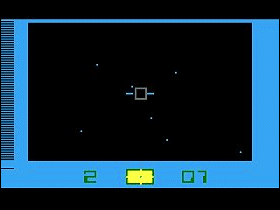 The Game: Patrolling the space lanes isn’t easy – ever noticed how many regions of space are teeming with hostile aliens? Your tour of duty aboard the Star Voyager is no different. Using a simple radar device for guidance, you have to track down alien ships and destroy them before they can return the favor. However, you have a limited energy reserve with which to accomplish this task. Alien hits on your ship will significantly deplete your energy, and firing your own lasers also gradually bleeds your ship dry. The only opportunity you have to replenish your energy is to defeat all the aliens within range and pass through a stargate. When you run out of energy, you’re out of luck. (Imagic, 1982)
The Game: Patrolling the space lanes isn’t easy – ever noticed how many regions of space are teeming with hostile aliens? Your tour of duty aboard the Star Voyager is no different. Using a simple radar device for guidance, you have to track down alien ships and destroy them before they can return the favor. However, you have a limited energy reserve with which to accomplish this task. Alien hits on your ship will significantly deplete your energy, and firing your own lasers also gradually bleeds your ship dry. The only opportunity you have to replenish your energy is to defeat all the aliens within range and pass through a stargate. When you run out of energy, you’re out of luck. (Imagic, 1982)
Memories: This fairly simple first-person space shoot ’em up – less complicated than either Star Raiders or Activision‘s Starmaster – was one of the best attempts of its era at a 3-D game on the 2600.
Star Trek: The Motion Picture
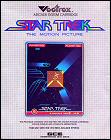 The Game: You’re at the helm of the U.S.S. Enterprise – that’s the cool part. The not-so-cool part? You’re in disputed territory – and the Klingons are bringing the fight to you en masse, attacking both the Enterprise and local Starbases, which you have the defend (lest you be left with no place to refuel). Use your phasers, photon torpedoes and shields judiciously – and do whatever it takes to halt the Klingon advance before they overrun Federation space. (GCE, 1982)
The Game: You’re at the helm of the U.S.S. Enterprise – that’s the cool part. The not-so-cool part? You’re in disputed territory – and the Klingons are bringing the fight to you en masse, attacking both the Enterprise and local Starbases, which you have the defend (lest you be left with no place to refuel). Use your phasers, photon torpedoes and shields judiciously – and do whatever it takes to halt the Klingon advance before they overrun Federation space. (GCE, 1982)
Memories: When the Enterprise returned by way of movie screens around the world in 1979, the sets and other visual details depicting the ship were brought right up to date to withstand big-screen scrutiny (and anticipated repeat viewing – though probably not even the movie’s makers knew to what degree that would be the case). The Enterprise’s onboard computers were shown to display, among other things, vector-graphics-style tactical displays – a fact not lost on the makers of the Vectrex console. Marrying the two was only – dare I say it? – logical.
Spy’s Demise (Apple II)
 The Game: Players control a spy sneaking through a building looking for secret information. High-speed elevators zoom up and down their cables throughout each floor at random intervals, making it difficult to accomplish the goal of crossing to the other side of the screen (the only way to ascend to the next floor). It takes skill, timing and nerves of steel to keep one’s spies from their demise. (Penguin Software, 1982)
The Game: Players control a spy sneaking through a building looking for secret information. High-speed elevators zoom up and down their cables throughout each floor at random intervals, making it difficult to accomplish the goal of crossing to the other side of the screen (the only way to ascend to the next floor). It takes skill, timing and nerves of steel to keep one’s spies from their demise. (Penguin Software, 1982)
Memories: An addictively fun and frustrating early entry on the Apple II computer, Alan Zeldin’s Spy’s Demise gave players some real elevator action.
Spider Fighter
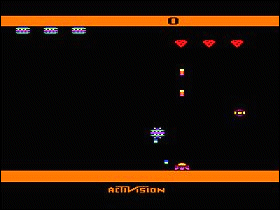
 The Game: It’s a full-scale infestation! Spiteful spiders are hatching everywhere you look, and they’ve got an eye on feeding and breeding. Your blaster is the only thing stopping them, and you’ve got to be lightning fast. (Activision, 1982)
The Game: It’s a full-scale infestation! Spiteful spiders are hatching everywhere you look, and they’ve got an eye on feeding and breeding. Your blaster is the only thing stopping them, and you’ve got to be lightning fast. (Activision, 1982)
Memories: Possibly the most original arcade-ish game Activision released for the Atari 2600, Spider Fighter is a fast and furious shoot-’em-up requiring a lot of fast thinking; it’s also refreshingly free of the flicker that plagues so many 2600 games.
Space Fury
 The Game: The Space Fury Commander – a big one-eyed dude with a veiny green cranium – challenges you to a duel. One slight problem: you’ve just got one ship and can only shoot in one direction at a time, and he has a whole battle fleet bent on your destruction. After surviving a round of his contest, you get the chance to dock with an enhancement module that will allow you to fire shots in several directions at once, or fire more powerful shots. The Commander always comes back to taunt you. When you lose all of your ships, the game is over, and one-eye gets to gloat. (Coleco [under license from Sega/Gremlin], 1982)
The Game: The Space Fury Commander – a big one-eyed dude with a veiny green cranium – challenges you to a duel. One slight problem: you’ve just got one ship and can only shoot in one direction at a time, and he has a whole battle fleet bent on your destruction. After surviving a round of his contest, you get the chance to dock with an enhancement module that will allow you to fire shots in several directions at once, or fire more powerful shots. The Commander always comes back to taunt you. When you lose all of your ships, the game is over, and one-eye gets to gloat. (Coleco [under license from Sega/Gremlin], 1982)
Memories: A better-than-decent adaptation of the cult arcade classic, Space Fury is that rare raster title that makes a virtue of having been adapted from an arcade game with a completely different graphics system. Space Fury spoke in the arcades with a robust speech synthesizer; ColecoVision Space Fury puts the Commander’s banter on the screen as a scrolling subtitle.
Spiders
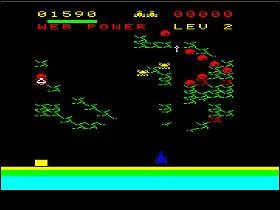 The Game: Spiders slink down from the top of the screen, constructing an elaborate web and laying eggs as they go. The player, manning a mobile bug-blasting cannon, can take out the spiders, but the eggs are still gestating and will hatch new spiders unless they’re destroyed; new spiders repeat the cycle in rapid succession. Spiders will manage to build their web to the bottom of the screen, restricting the cannon’s movement (and creating zones of the screen where future spider hatchlings can move unimpeded). The game ends when the player loses all of the cannons to the spiders or their incoming fire. (Emerson, 1982)
The Game: Spiders slink down from the top of the screen, constructing an elaborate web and laying eggs as they go. The player, manning a mobile bug-blasting cannon, can take out the spiders, but the eggs are still gestating and will hatch new spiders unless they’re destroyed; new spiders repeat the cycle in rapid succession. Spiders will manage to build their web to the bottom of the screen, restricting the cannon’s movement (and creating zones of the screen where future spider hatchlings can move unimpeded). The game ends when the player loses all of the cannons to the spiders or their incoming fire. (Emerson, 1982)
Memories: In this early epoch of the video game industry, there seemed to be a perception that you simply weren’t taking things seriously unless you secured an arcade license. Witness the Odyssey2, whose sole first-party licensed arcade port came too late in the machine’s library to bolster its popularity, or the Intellivision, which avoided arcade ports at first and then broke through to widespread popularity with a licensed home version of Burgertime.
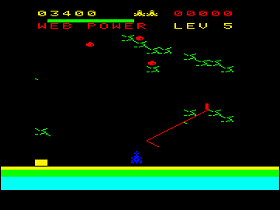 Not wanting to be a casualty of the video game wars, Emerson landed a handful of relatively obscure arcade licenses such as Jungler, Funky Fish and Spiders – none of them exactly household names in the coin-op world. (Most people probably can’t even remember seeing these games in the arcade at all; the author of this review barely remembers seeing Spiders and Jungler in the flesh.) Spiders was actually this vague and abstract in the arcade, too, so it’s really not a bad port, especially on the Arcadia 2001.
Not wanting to be a casualty of the video game wars, Emerson landed a handful of relatively obscure arcade licenses such as Jungler, Funky Fish and Spiders – none of them exactly household names in the coin-op world. (Most people probably can’t even remember seeing these games in the arcade at all; the author of this review barely remembers seeing Spiders and Jungler in the flesh.) Spiders was actually this vague and abstract in the arcade, too, so it’s really not a bad port, especially on the Arcadia 2001.
 For such an obscure arcade game, Spiders got around; there was also a fairly entertaining Entex tabletop game, though its matrix of fixed graphics made it much more difficult to figure out what was going on. The Arcadia version is fairly faithful to the original, duplicating the utter strangeness of the coin-op original nicely.
For such an obscure arcade game, Spiders got around; there was also a fairly entertaining Entex tabletop game, though its matrix of fixed graphics made it much more difficult to figure out what was going on. The Arcadia version is fairly faithful to the original, duplicating the utter strangeness of the coin-op original nicely.
Smurf: Rescue From Gargamel’s Castle
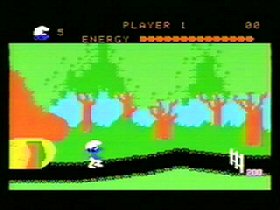 The Game: You are an unidentified Smurf en route to save Smurfette from Gargamel’s castle. Now, you may think that Gargamel would deploy his vicious black cat to stop you from reaching that goal, but that sort
The Game: You are an unidentified Smurf en route to save Smurfette from Gargamel’s castle. Now, you may think that Gargamel would deploy his vicious black cat to stop you from reaching that goal, but that sort  of melodramatic stuff only happens in cartoons. Real Smurfs can be felled by something as innocuous as a fall off a very short ledge or running into clumps of grass. (Coleco, 1982)
of melodramatic stuff only happens in cartoons. Real Smurfs can be felled by something as innocuous as a fall off a very short ledge or running into clumps of grass. (Coleco, 1982)
Memories: The early 80s: video games were hot, new wave music was now mainstream, everybody who was anybody had given Rubik’s Cube a twist, and of course, there were Smurfs all over the place. Now, setting aside the fact that with the plural of knife being knives and the plural of scarf being scarves, the plural of Smurf should be Smurves, Peyo’s little blue critters were all over the place – cartoons, clothing, lunchboxes, toys, and more. You’d think that a market would have arisen for an effective Smurf repellant, perhaps in an environmentally-friendly non-aerosol spray form, but instead Coleco gave us this marvelous video game, in which those so inclined could send hundreds of the little pests hurtling headlong, lemming-like, to their death.
SID The Spellbinder!
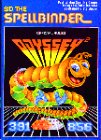 The Game: What happens when the Dreaded Dratapillar Of Venus makes a guest appearance? It means that a spelling bee is imminent! A friendly voice warns you to look out for a “monster attack,” and after dispatching all of the segments of the worm-like invader, you’re asked to correctly spell three words using the Odyssey2 keyboard. Once you’ve correctly spelled those three words, another monster attack occurs, with the Dratapillar moving faster in each successive level; the game continues until it descends far enough down the screen to reach your cannon. (North American Philips, 1982)
The Game: What happens when the Dreaded Dratapillar Of Venus makes a guest appearance? It means that a spelling bee is imminent! A friendly voice warns you to look out for a “monster attack,” and after dispatching all of the segments of the worm-like invader, you’re asked to correctly spell three words using the Odyssey2 keyboard. Once you’ve correctly spelled those three words, another monster attack occurs, with the Dratapillar moving faster in each successive level; the game continues until it descends far enough down the screen to reach your cannon. (North American Philips, 1982)
Memories: Programmed by Sam Overton, SID The Spellbinder! was one of the first two – and, as it so happened, only two – educational launch titles made available specifically for the then-new Voice Of Odyssey speech synthesizer.
Room Of Doom
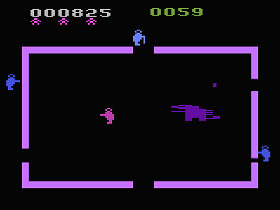 The Game: One man and one hideous mutant creature enter! A bunch of guys peek through holes in the walls and shoot at them! No one leaves! Room Of Doom turns the player into a gladiator, trapped in an enclosed arena with alien creatures. The rules are simple: kill or be killed. The only problem is that it’s always audience participation night: armed guards around the periphery of the arena will open doors at random and fire into the arena. With a well-timed shot before the doors slide shut, the player can do away with these extraneous attackers too. Only by eliminating all of the guards can the player advance to the next level. (Commavid, 1982)
The Game: One man and one hideous mutant creature enter! A bunch of guys peek through holes in the walls and shoot at them! No one leaves! Room Of Doom turns the player into a gladiator, trapped in an enclosed arena with alien creatures. The rules are simple: kill or be killed. The only problem is that it’s always audience participation night: armed guards around the periphery of the arena will open doors at random and fire into the arena. With a well-timed shot before the doors slide shut, the player can do away with these extraneous attackers too. Only by eliminating all of the guards can the player advance to the next level. (Commavid, 1982)
Memories: One of those games that doesn’t exactly look sophisticated but is actually kind of addictive, Room Of Doom was heavily promoted by Commavid back in the day by way of an extensive print advertising campaign in the major video game magazines. Those print ads concentrated more on the stylized packaging artwork than the game graphics themselves, which was probably wise, but Room Of Doom is no slouch when it comes to pure fun.
Qix
 The Game: You control a “marker,” trying to claim as much of the playing field as you can by enclosing areas of it. Drawing your boundaries faster is safer, but yields fewer points. A slower draw, which leaves you vulnerable to attack from the Qix and the Sparx, gives you many more points upon the completion of an enclosed area. If the ever-shifting Qix touches your marker or an uncompleted boundary you are drawing, you lose a “life” and start again. And the Sparx, which travel only along the edges of the playing field and along the boundaries of areas of the screen you’ve already enclosed, can destroy you by touching your marker. And if you linger too long, a fuse will begin burning at the beginning of your unfinished boundary, and will eventually catch up with you. (Atari, 1982)
The Game: You control a “marker,” trying to claim as much of the playing field as you can by enclosing areas of it. Drawing your boundaries faster is safer, but yields fewer points. A slower draw, which leaves you vulnerable to attack from the Qix and the Sparx, gives you many more points upon the completion of an enclosed area. If the ever-shifting Qix touches your marker or an uncompleted boundary you are drawing, you lose a “life” and start again. And the Sparx, which travel only along the edges of the playing field and along the boundaries of areas of the screen you’ve already enclosed, can destroy you by touching your marker. And if you linger too long, a fuse will begin burning at the beginning of your unfinished boundary, and will eventually catch up with you. (Atari, 1982)
Memories: One can think of no better early 80s platform for Qix than the Atari 5200, and it almost manages to pull off a perfect translation. Qix is another case where the infamous 5200 joysticks can confound your efforts to draw a straight line, but a lot of games have that problem, and I can’t really hold the grudge against anyone but whoever it was who designed those controllers.

Phoenix
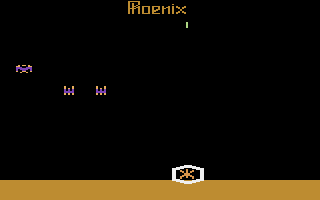 The Game: In a heavily armed space fighter, your job is pretty simple – ward off wave after wave of bird-like advance fighters and Phoenix creatures until you get to the mothership, and then try to blow that to smithereens. All of which would be simple if not for the aliens’ unpredictable kamikaze dive-bombing patterns. The Phoenix creatures themselves are notoriously difficult to kill, requiring a direct hit in the center to destroy them – otherwise they’ll grow back whatever wings you managed to pick off of them and come back even stronger. (Atari, 1982)
The Game: In a heavily armed space fighter, your job is pretty simple – ward off wave after wave of bird-like advance fighters and Phoenix creatures until you get to the mothership, and then try to blow that to smithereens. All of which would be simple if not for the aliens’ unpredictable kamikaze dive-bombing patterns. The Phoenix creatures themselves are notoriously difficult to kill, requiring a direct hit in the center to destroy them – otherwise they’ll grow back whatever wings you managed to pick off of them and come back even stronger. (Atari, 1982)
Memories: A very good translation, this. Atari’s edition of Phoenix opted to skimp a little on the graphics of the arcade original (which, truthfully, weren’t that elaborate to begin with) and concentrated more on duplicating the maddeningly random attacks of the enemy birds from its coin-op forebear. The result is an extremely playable, addictive slice of the arcade right in your living room.
Pac-Man
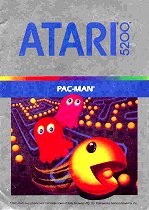 The Game: As a round yellow creature consisting of a mouth and nothing else, you maneuver around a relatively simple maze, gobbling small dots and evading four colorful monsters who can eat you on contact. In four corners of the screen, large flashing dots enable you to turn the tables and eat the monsters for a brief period for an escalating score . Periodically, assorted items appear near the center of the maze, and you can consume these for additional points as well. The monsters, once eaten, return to their home base in ghost form and return to chase you anew. If cleared of dots, the maze refills and the game starts again, but just a little bit faster… (Atari, 1982)
The Game: As a round yellow creature consisting of a mouth and nothing else, you maneuver around a relatively simple maze, gobbling small dots and evading four colorful monsters who can eat you on contact. In four corners of the screen, large flashing dots enable you to turn the tables and eat the monsters for a brief period for an escalating score . Periodically, assorted items appear near the center of the maze, and you can consume these for additional points as well. The monsters, once eaten, return to their home base in ghost form and return to chase you anew. If cleared of dots, the maze refills and the game starts again, but just a little bit faster… (Atari, 1982)
Memories: In the war of the second-generation consoles, it was clear what the chief ammunition would be: immensely popular arcade game licenses. The ColecoVision jumped out of the gates with Donkey Kong as a pack-in title, and Atari – already fighting bad word-of-mouth criticism of the 5200’s lackluster joysticks – would have to give the SuperSystem something a little more compelling than its cousin 2600’s Combat pack-in. But then, of course, everyone already knew that Atari held that most precious of arcade licenses in the early 80s, Pac-Man.
Night Stalker

 The Game: You’re alone, unarmed, in a maze full of bats, bugs and ‘bots, most of whom can kill you on contact (though the robots would happily shoot you rather than catching up with you). Loaded guns appear periodically, giving you a limited number of rounds with which to take out some of these creepy foes, though your shots are best reserved for the robots and the spiders, who have a slightly more malicious intent toward you than the bats. If you shoot the bats, others will appear to take their place. If you shoot the ‘bots, the same thing happens, only a faster, sharper-shooting model rolls out every time. Your best bet is to stay on the move, stay armed, conserve your firepower – and don’t be afraid to head back to your safe room at the center of the screen. (Mattel Electronics, 1982)
The Game: You’re alone, unarmed, in a maze full of bats, bugs and ‘bots, most of whom can kill you on contact (though the robots would happily shoot you rather than catching up with you). Loaded guns appear periodically, giving you a limited number of rounds with which to take out some of these creepy foes, though your shots are best reserved for the robots and the spiders, who have a slightly more malicious intent toward you than the bats. If you shoot the bats, others will appear to take their place. If you shoot the ‘bots, the same thing happens, only a faster, sharper-shooting model rolls out every time. Your best bet is to stay on the move, stay armed, conserve your firepower – and don’t be afraid to head back to your safe room at the center of the screen. (Mattel Electronics, 1982)
Memories: A devious and nerve-wracking little maze chase of a game, Night Stalker is a great game if you’re up for an endurance contest, but not so much if you’re looking for a game where you actually stand a chance of winning or advancing to a new maze. The playing field you see is the playing field you get, and you’re stuck there – until you die.
Mouse Trap
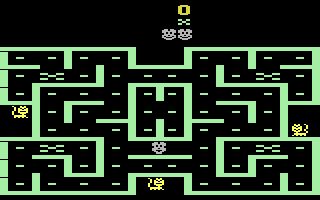 The Game: In this munching-maze game (one of the dozens of such games which popped up in the wake of Pac-Man), you control a cartoonish mouse who scurries around a cheese-filled maze which can only be navigated by strategically opening and closing doors in the maze. Occasionally a big chunk o’ cheese can be gobbled for extra points. Is it that easy? No. There is also a herd of hungry kitties who would love a mousy morsel. But you’re not defenseless. By eating a bone (the equivalent of Pac-Man’s power pellets), you can transform into a dog, capable of eating the cats. But each bone’s effects only last for a little while, after which you revert to a defenseless mouse. (Coleco, 1982)
The Game: In this munching-maze game (one of the dozens of such games which popped up in the wake of Pac-Man), you control a cartoonish mouse who scurries around a cheese-filled maze which can only be navigated by strategically opening and closing doors in the maze. Occasionally a big chunk o’ cheese can be gobbled for extra points. Is it that easy? No. There is also a herd of hungry kitties who would love a mousy morsel. But you’re not defenseless. By eating a bone (the equivalent of Pac-Man’s power pellets), you can transform into a dog, capable of eating the cats. But each bone’s effects only last for a little while, after which you revert to a defenseless mouse. (Coleco, 1982)
Memories: To some extent, I think regular readers of Phosphor Dot Fossils have come to expect certain things…and the occasional justified slamming of a 2600 game or two is probably one of them. But not this one. No, I’m here to tell you that I love Coleco’s 2600 translation of the obscure Exidy coin-op maze chase Mouse Trap. Yes, seriously!
Megamania
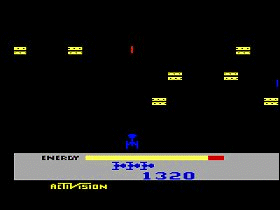
 The Game: The sky is falling! Or so it seems. As this game is subtitled “A Space Nightmare,” you’re not battling aliens here, but ever-descendig and evading waves of such ordinary items as bow ties, hamburgers, dice, and so on. Unlike so many other Space Invaders variations, you won’t die the moment the attacking forces reach ground zero – but you could, if they slide horizontally right into you. (Activision, 1982)
The Game: The sky is falling! Or so it seems. As this game is subtitled “A Space Nightmare,” you’re not battling aliens here, but ever-descendig and evading waves of such ordinary items as bow ties, hamburgers, dice, and so on. Unlike so many other Space Invaders variations, you won’t die the moment the attacking forces reach ground zero – but you could, if they slide horizontally right into you. (Activision, 1982)
Memories: Activision, much like the Odyssey 2 game designers, always knew how to put enough of a twist on game with an established “formula” to keep the litigious wolf from the door, and this is another classic example of that – not to mention an annoyingly addictive little game.
Loco Motion
 The Game: A train scoots around a twisty maze of tiles representing overpasses, turns, straightaways and terminals. One portion of the maze is blank, and a train will be lost if it hits that blank tile. You can move the blank tile and one adjacent tile around on the map – even if the train is in transit on that tile – in an effort to keep it moving around the maze, picking up passengers. (Passengers that the train can reach are smiley faces; passengers cut off from the main route are frowning.) If any passengers are cut off for an extended period of time, a monster begins wandering that route, and it’ll cost you a train if it comes in contact with your train. You may have to outrun it with the “speed” button in order to pick up the last passengers and clear the level to move on to a bigger maze. (Mattel [under license from Konami], 1982)
The Game: A train scoots around a twisty maze of tiles representing overpasses, turns, straightaways and terminals. One portion of the maze is blank, and a train will be lost if it hits that blank tile. You can move the blank tile and one adjacent tile around on the map – even if the train is in transit on that tile – in an effort to keep it moving around the maze, picking up passengers. (Passengers that the train can reach are smiley faces; passengers cut off from the main route are frowning.) If any passengers are cut off for an extended period of time, a monster begins wandering that route, and it’ll cost you a train if it comes in contact with your train. You may have to outrun it with the “speed” button in order to pick up the last passengers and clear the level to move on to a bigger maze. (Mattel [under license from Konami], 1982)
Memories: Mattel’s licensed adaptation of the extremely minor arcade hit by Konami is actually, believe it or not, an improvement in some areas on the arcade game. The graphic look isn’t one of those areas, but in a strange way, the Intellivision’s disc controller is more instinctive for the sliding-tile-puzzle game play of Loco Motion.
Ladybug
 The Game: You’re a hungry ladybug in a maze full of dangers and morsels. Other insects roam the maze trying to eat you, and skulls scattered around the maze are also deadly to the touch. The only advantage you really have is to maneuver skillfully through the revolving doors, slamming them shut behind you and forcing your pursuers to take a different route (they can’t go through the revolving doors). (Coleco, 1982)
The Game: You’re a hungry ladybug in a maze full of dangers and morsels. Other insects roam the maze trying to eat you, and skulls scattered around the maze are also deadly to the touch. The only advantage you really have is to maneuver skillfully through the revolving doors, slamming them shut behind you and forcing your pursuers to take a different route (they can’t go through the revolving doors). (Coleco, 1982)
Memories: With the rights to mega-hits like Pac-Man taken by the time the ColecoVision hit the stores, Coleco grabbed the rights to a number of somewhat more obscure arcade games, including virtually the entire catalog of Universal games, the makers of such games as Mr. Do, Mr. Do’s Castle, and Ladybug. Coleco’s Ladybug cartridge is a very faithful rendition of its arcade inspiration, and it’s quite a bit of fun.
Keystone Kapers
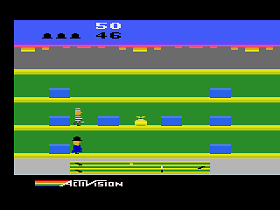
 The Game: Kriminals are on the loose in an unspecified retail establishment, and you happen to be the lone kop on the kase. Bouncy balls, shopping karts and other krap get in your way as you try to katch the kriminal before time runs out. You might get lucky and hitch an elevator ride, or you may have to take the escalators at opposite ends of the store, which will take more time. If you don’t kapture the krook, he gets away with the loot. (Activision, 1982)
The Game: Kriminals are on the loose in an unspecified retail establishment, and you happen to be the lone kop on the kase. Bouncy balls, shopping karts and other krap get in your way as you try to katch the kriminal before time runs out. You might get lucky and hitch an elevator ride, or you may have to take the escalators at opposite ends of the store, which will take more time. If you don’t kapture the krook, he gets away with the loot. (Activision, 1982)
Memories: A simple little game from the hallowed house of Activision, Keystone Kapers is one of those games you really don’t need the docs to play.
Jawbreaker
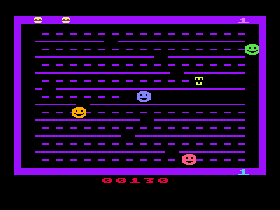 The Game: Ever had a sweet tooth? Now you are the sweet tooth – or teeth, as the case may be. You guide a set of clattering teeth around a mazelike screen of horizontal rows; an opening in each row travels down the wall separating it from the next row. Your job is to eat the tasty treats lining each row until you’ve cleared the screen. Naturally, it’s not just going to be that easy. There are nasty hard candies out to stop you, and they’ll silence those teeth of yours if they catch you – and that just bites. Periodically, a treat appears in the middle of the screen allowing you to turn the tables on them for a brief interval. (Tigervision, 1982)
The Game: Ever had a sweet tooth? Now you are the sweet tooth – or teeth, as the case may be. You guide a set of clattering teeth around a mazelike screen of horizontal rows; an opening in each row travels down the wall separating it from the next row. Your job is to eat the tasty treats lining each row until you’ve cleared the screen. Naturally, it’s not just going to be that easy. There are nasty hard candies out to stop you, and they’ll silence those teeth of yours if they catch you – and that just bites. Periodically, a treat appears in the middle of the screen allowing you to turn the tables on them for a brief interval. (Tigervision, 1982)
Memories: When Atari’s licensed version of Pac-Man hit the store shelves in 1982, it gained an instant notoriety as those looking for the perfect home Pac experience muttered a collective “screw this” and went elsewhere in search of a better game. Tigervision, a subsidiary of Tiger Toys making its first tentative steps into the increasingly-crowded video game arena, gave them that game.
Grand Prix (Atari 2600)
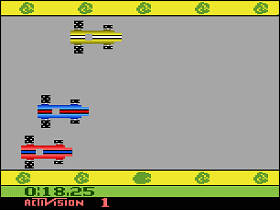
 The Game: Start your digital engines! Grand Prix puts the player behind the wheel of a sleek (and, it has to be said, colorful) race car. With the track scrolling from right to left, the game is simple: get ahead, and don’t crash into the other cars. That may sound easy enough, but hazards such as oil slicks can send a car spinning out of control very easily. (Activision, 1982)
The Game: Start your digital engines! Grand Prix puts the player behind the wheel of a sleek (and, it has to be said, colorful) race car. With the track scrolling from right to left, the game is simple: get ahead, and don’t crash into the other cars. That may sound easy enough, but hazards such as oil slicks can send a car spinning out of control very easily. (Activision, 1982)
Memories: One of David Crane’s earliest games at Activision, Grand Prix is almost as important as a tech demo as it is as a game. Consider the large, blocky pixel-cars Atari‘s first-party racing games; the colorful, finely-detailed cars in Crane’s Grand Prix were a revelation by comparison. Grand Prix brought us cars of many different colors, with animated tires, and none of the sprite flicker that had already come to characterize many a 2600 game by this point. It was yet another case of Activision putting Atari on notice to start bringing its “A” game – literally.
Fishing Derby
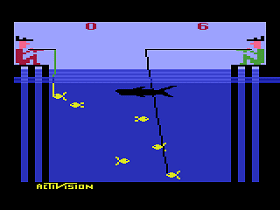 The Game: You (and a friend, in the two-player game) are sitting on the dock of the bay, watching the time float away, and trying to catch some dinner at the same time. There’s only one problem: apparently Roy Scheider led you to this fishin’
The Game: You (and a friend, in the two-player game) are sitting on the dock of the bay, watching the time float away, and trying to catch some dinner at the same time. There’s only one problem: apparently Roy Scheider led you to this fishin’  hole, because there’s a shark roaming the waters near the surface – and he’ll happily eat your fish (the shark, that is, not Roy Scheider) if you happen to reel them in while he’s facing you. Some of the fish will put up a mighty struggle when caught, which can also lead them to a date with the shark. The first to snag a hundred fishies wins. (Activision, 1982)
hole, because there’s a shark roaming the waters near the surface – and he’ll happily eat your fish (the shark, that is, not Roy Scheider) if you happen to reel them in while he’s facing you. Some of the fish will put up a mighty struggle when caught, which can also lead them to a date with the shark. The first to snag a hundred fishies wins. (Activision, 1982)
Memories: Put away the current gen fishing reel controllers, this is where the odd sport of video fishing began. Fishing Derby, one of Activision’s early offerings, is proof that, once upon a time, imagination dominated the game-making scene instead of marketing considerations reigning supreme.
Galaxian
 The Game: In one of the most seminal variations on the Space Invaders format, Galaxian was among the first clones to introduce attacking formations that would break off from the usual rows and columns of invaders. Though Galaxian‘s use of this innovation was minimal, it was a drastic change from the usual slowly-advancing target gallery. (Atari, 1982)
The Game: In one of the most seminal variations on the Space Invaders format, Galaxian was among the first clones to introduce attacking formations that would break off from the usual rows and columns of invaders. Though Galaxian‘s use of this innovation was minimal, it was a drastic change from the usual slowly-advancing target gallery. (Atari, 1982)
Memories: Like the 5200 version of Pac-Man, Galaxian is a good demonstration of the next-generation Atari console soundly trouncing its older brother. Galaxian is no slouch on the Atari 2600,  but while the game play is relatively intact, the look and feel of the arcade game didn’t survive that particular translation. Those elements are handled much more faithfully in this version of the game, though.
but while the game play is relatively intact, the look and feel of the arcade game didn’t survive that particular translation. Those elements are handled much more faithfully in this version of the game, though.
The Empire Strikes Back
 The Game: Derived from an action scene in the second of a trilogy of little-known films about a budding Jedi Knight named Luke Skywalker, The Empire Strikes Back puts you in the cockpit of Luke’s snowspeeder in a desperate bid to beat back huge Imperial Walkers – also known as AT-ATs – from destroying the Rebel back on the ice planet of Hoth. The AT-ATs’ heavy artillery can seriously deplete your snowspeeder’s shielding with a single hit, though you must score numerous direct hits before you can even begin to have the same effect on the onslaught of Imperial Walkers, let alone destroy one. Occasionally, a weakness will be exposed in the “neck” region of the huge mechanical monsters, and you’ll have a few seconds in which you may take advantage of that and blow the machine away. And even less frequently, the triumphant strains of John Williams’ Star Wars theme – as squeaked out by the Atari 2600’s limited sound facility – will signal that the Force is with you, rendering you invincible for a short period of time. You’re going to need it. (Parker Brothers, 1982)
The Game: Derived from an action scene in the second of a trilogy of little-known films about a budding Jedi Knight named Luke Skywalker, The Empire Strikes Back puts you in the cockpit of Luke’s snowspeeder in a desperate bid to beat back huge Imperial Walkers – also known as AT-ATs – from destroying the Rebel back on the ice planet of Hoth. The AT-ATs’ heavy artillery can seriously deplete your snowspeeder’s shielding with a single hit, though you must score numerous direct hits before you can even begin to have the same effect on the onslaught of Imperial Walkers, let alone destroy one. Occasionally, a weakness will be exposed in the “neck” region of the huge mechanical monsters, and you’ll have a few seconds in which you may take advantage of that and blow the machine away. And even less frequently, the triumphant strains of John Williams’ Star Wars theme – as squeaked out by the Atari 2600’s limited sound facility – will signal that the Force is with you, rendering you invincible for a short period of time. You’re going to need it. (Parker Brothers, 1982)
Memories: The Empire Strikes Back is just one in a series of excellent Star Wars-themed game cartridges released around this time by Parker Brothers (other titles included Star Wars: The Arcade Game, an excellent adaptation of the Atari vector arcade game, and the intriguing Return of the Jedi: Death Star Battle).
Dragonfire
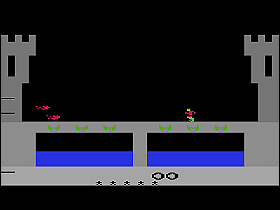 The Game: Introducing the ultimate in home security systems: a huge fire-breathing dragon. No keypads or extra power sources necessary! The amazing new dragon will repel any looters from the castle he’s guarding by belching unpredictable barrages of fire across the castle drawbridge. And even if an intrepid looter does gain access to the castle, the dragon will fend off the unwelcome visitor’s attempts to grab the castle’s treasure with an endless hail of fireballs, toasting the looter on contact. If the looter should happen to grab all the treasure – which is highly, highly unlikely due to the rugged design of the dragon – an escape hatch will appear and he’s free to try his luck from the drawbridge again. But it’s very unlikely that any looter will survive a second attempt…which is actually rather unfortunate, since you’re the treasure hunter in this game. (Imagic, 1982)
The Game: Introducing the ultimate in home security systems: a huge fire-breathing dragon. No keypads or extra power sources necessary! The amazing new dragon will repel any looters from the castle he’s guarding by belching unpredictable barrages of fire across the castle drawbridge. And even if an intrepid looter does gain access to the castle, the dragon will fend off the unwelcome visitor’s attempts to grab the castle’s treasure with an endless hail of fireballs, toasting the looter on contact. If the looter should happen to grab all the treasure – which is highly, highly unlikely due to the rugged design of the dragon – an escape hatch will appear and he’s free to try his luck from the drawbridge again. But it’s very unlikely that any looter will survive a second attempt…which is actually rather unfortunate, since you’re the treasure hunter in this game. (Imagic, 1982)
Memories: An addictive little number, this Dragonfire. Granted, the Intellivision version of this game looks fancier – well, compared to the 2600 cartridge, almost every other version of Dragonfire has a little more audiovisual flair.
Donkey Kong
 The Game: In a very faithful adaptation of Nintendo’s all-time classic arcade game, you’re Mario, a rotund and lovesick fellow who would gladly scale scaffolding, bound over barrels and feint past foxfires, all to save the damsel in distress. (Coleco, 1982)
The Game: In a very faithful adaptation of Nintendo’s all-time classic arcade game, you’re Mario, a rotund and lovesick fellow who would gladly scale scaffolding, bound over barrels and feint past foxfires, all to save the damsel in distress. (Coleco, 1982)
The Game: This was it, friends. This was what sold the ColecoVision. Donkey Kong was one of the hottest games in arcades at that time, and Coleco was smart enough to grab the rights from Nintendo as well as to make it the pack-in cartridge for the ColecoVision (like Combat was the pack-in for the Atari 2600).
Dark Caverns
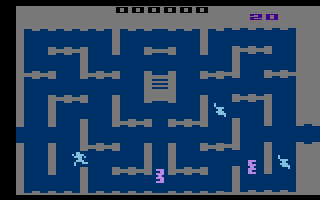 The Game: Robots, spiders and critters, oh my! You’re a lone human in a maze teeming with deadly robots, spiders and other nasties, and your trusty gun – which can dispatch any or all of the above – has only a limited amount of ammunition. You can obtain more ammo by walking over a briefly-occurring flashing gun symbol – but until then, if you’re out of ammo, you’re no longer the hunter, but the hunted. (M Network [Mattel], 1982)
The Game: Robots, spiders and critters, oh my! You’re a lone human in a maze teeming with deadly robots, spiders and other nasties, and your trusty gun – which can dispatch any or all of the above – has only a limited amount of ammunition. You can obtain more ammo by walking over a briefly-occurring flashing gun symbol – but until then, if you’re out of ammo, you’re no longer the hunter, but the hunted. (M Network [Mattel], 1982)
Memories: This was the 2600 version of a similar game that Mattel had released for its own Intellivision console (Night Stalker), and it’s fair to say that this edition was just a wee bit simplified.
Cosmic Ark
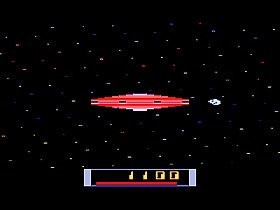 The Game: As the commander of a spacefaring Ark, your mission is to retrieve two members of every species on every planet you visit, in case the constant ruch of asteroids and meteors renders life on those planets extinct. In the initial screen, the large Ark spacecraft is besieged by meteors appearing from every direction, and your job is to use the ship’s weapons the destroy the space rock before they destroy your Ark. After surviving this screen, the Ark descends into low orbit of a planet, and you pilot the scout ship, avoiding planetary defenses to grab two specimens of that planet’s dominant life form with your tractor beam. (Sorry, you don’t get to make crop circles while you’re doing your alien abductions.) If the planetary defenses hit your scout ship, you launch another one, but time is running out – eventually another meteor will plummet from the sky right into the Ark, and you can only defend the Ark if the scout ship has re-docked. When the final destruction of the Cosmic Ark comes at last, the tiny scout ship escapes into deep space… (Imagic, 1982)
The Game: As the commander of a spacefaring Ark, your mission is to retrieve two members of every species on every planet you visit, in case the constant ruch of asteroids and meteors renders life on those planets extinct. In the initial screen, the large Ark spacecraft is besieged by meteors appearing from every direction, and your job is to use the ship’s weapons the destroy the space rock before they destroy your Ark. After surviving this screen, the Ark descends into low orbit of a planet, and you pilot the scout ship, avoiding planetary defenses to grab two specimens of that planet’s dominant life form with your tractor beam. (Sorry, you don’t get to make crop circles while you’re doing your alien abductions.) If the planetary defenses hit your scout ship, you launch another one, but time is running out – eventually another meteor will plummet from the sky right into the Ark, and you can only defend the Ark if the scout ship has re-docked. When the final destruction of the Cosmic Ark comes at last, the tiny scout ship escapes into deep space… (Imagic, 1982)
Memories: Another addictive entry, though a bit simpler than Atlantis, this game was way ahead of its time – an alien abduction game, even one which gives the player control of the aliens, would go over phenomenally with modern-day UFO enthusiasts.
Commando Raid
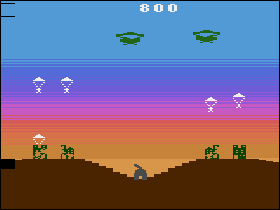 The Game: Helicopters and planes are dumping paratroopers directly over your land-locked cannon. Your job is to take out both aircraft and paratroopers before the enemy can land on and slowly destroy the rows of buildings on either side of the cannon. Once enemy paratroopers raze a building to the ground, they begin doing something even deadlier: digging tunnels toward your cannon so they can destroy it from below with a giant bomb, at which time your point defense career is over. (U.S. Games, 1982)
The Game: Helicopters and planes are dumping paratroopers directly over your land-locked cannon. Your job is to take out both aircraft and paratroopers before the enemy can land on and slowly destroy the rows of buildings on either side of the cannon. Once enemy paratroopers raze a building to the ground, they begin doing something even deadlier: digging tunnels toward your cannon so they can destroy it from below with a giant bomb, at which time your point defense career is over. (U.S. Games, 1982)
Memories: A clever riff on a well-known game, Commando Raid avoids being just another Missile Command clone. At first glance, the element of defending six cities/buildings by covering the entire sky from a fixed position seems familiar, but the gradual enemy occupation of territory beneath the player’s cannon adds an original twist and requires some new strategy.
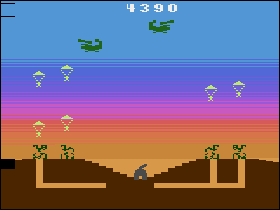 U.S. Games didn’t exactly make stuff that looked like Activision‘s games, but the audiovisual element of Commando Raid is more than adequate to convey all the information players need. The buildings have several stages of disrepair, from undamaged down to rubble. The sheer twitch factor as multiple incoming targets have to be dealt with is impressive for a VCS cartridge, as is the fact that the barrage of approaching enemies is accomplished with virtually none of the dreaded “flicker” that has plagued countless other games on this platform.
U.S. Games didn’t exactly make stuff that looked like Activision‘s games, but the audiovisual element of Commando Raid is more than adequate to convey all the information players need. The buildings have several stages of disrepair, from undamaged down to rubble. The sheer twitch factor as multiple incoming targets have to be dealt with is impressive for a VCS cartridge, as is the fact that the barrage of approaching enemies is accomplished with virtually none of the dreaded “flicker” that has plagued countless other games on this platform.
 Seasoned Missile Commanders looking for a new posting can do a lot worse than signing up to go Commando.
Seasoned Missile Commanders looking for a new posting can do a lot worse than signing up to go Commando.
Cosmic Creeps
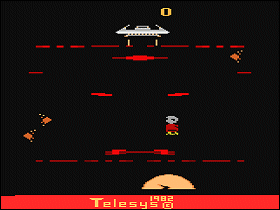 The Game: Aliens are after your kids! Fortunately, you’re armed with a resource that not everyone has: your own flying saucer. In the opening screen, you have to return to the saucer to resume command, and then you signal your kids to come up, one by one, as you try to pick off alien pursuers who are hot on their trail. If you’re not careful, you can actually zap the kids instead. If an alien manages to reach your saucer, someone else will have to give your kids a ride home from the star academy… (Telesys, 1982)
The Game: Aliens are after your kids! Fortunately, you’re armed with a resource that not everyone has: your own flying saucer. In the opening screen, you have to return to the saucer to resume command, and then you signal your kids to come up, one by one, as you try to pick off alien pursuers who are hot on their trail. If you’re not careful, you can actually zap the kids instead. If an alien manages to reach your saucer, someone else will have to give your kids a ride home from the star academy… (Telesys, 1982)
Memories: It may not have been the biggest, most obvious name in software for the 2600, but I have to give Telesys top marks for coming up with cool ideas for their games. Cosmic Creeps is a great example of what Telesys was best at, and it’s a lot of fun too.
Clean Sweep
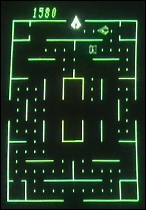 The Game: Years before Robovac and Roomba, there was Clean Sweep, a vacuum cleaner patrolling the vaults of a bank and picking up stray bits of money. (Makes you wonder who programmed it, and who’s emptying the bag!) As you grab more wayward currency, your bag fills up; when you hear an alarm sound, you have to go to the center of the maze to empty your bag and start anew; until you do that, you can’t pick up any more dead presidents. But those aren’t the only alarm bells going off here: things that look alarmingly like huge forceps are chasing you around. If they grab you, it’s your money and your life. There are four corners in the vault that will power up your vacuum cleaner temporarily, enabling you to suck up those forceps and (for a brief while) grab all the cash in your path without filling your bag. Clearing the maze advances you to the next level; losing all your lives leaves the bank wide open. (GCE, 1982)
The Game: Years before Robovac and Roomba, there was Clean Sweep, a vacuum cleaner patrolling the vaults of a bank and picking up stray bits of money. (Makes you wonder who programmed it, and who’s emptying the bag!) As you grab more wayward currency, your bag fills up; when you hear an alarm sound, you have to go to the center of the maze to empty your bag and start anew; until you do that, you can’t pick up any more dead presidents. But those aren’t the only alarm bells going off here: things that look alarmingly like huge forceps are chasing you around. If they grab you, it’s your money and your life. There are four corners in the vault that will power up your vacuum cleaner temporarily, enabling you to suck up those forceps and (for a brief while) grab all the cash in your path without filling your bag. Clearing the maze advances you to the next level; losing all your lives leaves the bank wide open. (GCE, 1982)
Memories: This interesting little take on Pac-Man for the Vectrex is so fun, it’s hard to put down. I’ve been somewhat merciless about Pac-clones in the past, but Clean Sweep shakes things up enough to be fun, making you go back and do things like empty your vacuum bag without really slowing the game down significantly.